
Asia Africa and Middle East: Far East Holiday & Coral Triangle Collector Cruise
Holland America Line
A mesmerizing adventure with scenic cruising through the Great Barrier Reef and past the Kumba Volcano, plus overnight stays in Laem Chabang (Bangkok) and Da Nang (Hue).

Executive Member Benefit
Executive Members receive an annual 2% Reward, up to $1,000, on qualified Costco Travel purchases
Digital Costco Shop Card
Member Exclusive: Digital Costco Shop Card with every Holland America Line sailing†
Sailing Itinerary

Note: Cruise itineraries are subject to change. Please verify ports and times directly with the cruise line.
Overview
Though physically small, Singapore is an economic giant. It has been Southeast Asia's most modern city for over a century. The city blends Malay, Chinese, Arab, Indian and English cultures and religions. Its unique ethnic tapestry affords visitors a wide array of sightseeing and culinary opportunities from which to choose. A full calendar of traditional festivals and holidays celebrated throughout the year adds to its cultural appeal. In addition, Singapore offers luxury hotels, delectable cuisine and great shopping! Located at the tip of the Malay Peninsula, Singapore's tropical climate welcomes both leisure and business travelers year round. The island republic's excellent infrastructure enables visitors to enjoy its many sites and attractions in a safe, clean and green environment. Award winning Changi Airport provides airlinks to major cities around the world. The train and subway systems are clean, fast and efficient. In addition, its state-of-the-art cruise terminal has established Singapore as one of the premier cruising centers of South East Asia and an exciting port of call on any Asian cruise itinerary. In the city, there is no need for a car. Public transportation is excellent and walking is a good way to explore the city . All major attractions are also accessible by tour bus. Since the city is only 60 miles (100k) from the equator, the tropical temperatures do not vary much. Rainfall is fairly evenly distributed through the year. No matter when you choose to visit, warm weather will be abundantly available. The visitor is struck immediately by Singapore's abundance of parks, nature reserves, and lush, tropical greenery. Singapore's progress over the past three decades has been remarkable, yet the island has not been overwhelmed by development. Visitors will discover a wealth of historical treasures from the past, in the beauty of older buildings, values and traditions that have survived in the face of profound social and geographical change. Lacking any noteworthy natural resources, Singapore's early prosperity was based on a vigorous free trade policy, put in place in 1819 when Sir Stamford Raffles first established it as a British trading post. Later, mass industrialization bolstered the economy, and today the state boasts the world's second busiest port after Rotterdam, minimal unemployment, and a super efficient infrastructure. Almost the entire population lives in upscale new apartments, and the average per capita income is over US$12,000. Singapore is a clean, safe place to visit, its amenities are second to none and its public places are smoke-free and hygienic. Forming the core of downtown Singapore is the Colonial District. Each surrounding enclave has its own distinct flavor, from the aromatic spice stores of Little India, to the tumbledown backstreets of Chinatown, where it is still possible to find calligraphers and fortune tellers, or the Arab Quarter, whose cluttered stores sell fine cloths and silks. North of the city, are two nature preserves, Bukit Timah and the Central Catchment Area, along with the splendid Singapore Zoological Gardens. The east coast features good seafood restaurants set on long stretches of sandy beach. In addition there are over fifty islands and islets within Singaporean waters, all of which can be reached with varying degrees of ease. Day trips are popular to Sentosa, the island amusement arcade which is linked to the south coast by a short causeway and cable car. Music, theater, nightlife: all are abundant in this remarkable city. Singapore used to be considered a "stop over" on the way to larger Asian cities. This is no longer true! Visitors seek out Singapore for business and finance and also for a fascinating and satisfying vacation for the whole family. Strategically located at the southern tip of the Malay Peninsula sixty miles from the equator, Singapore has for centuries been a crossroads between East and West. Chinese traders en route to India had navigated its waters from at least the 5th century. In the 14th century it was part of the powerful Vijayan Empire and was known as Tenmasek or Sea Town. Legend has it that it was renamed Singa Pura or Lion City after a visiting Sumatran prince saw an animal he mistook for a lion, an animal considered a good omen. Modern Singapore came into being in 1819 when Sir Stamford Raffles claimed what was then a small fishing village as a regional base for the East India Company. The island's natural harbor and location made it an ideal site for a trading post serving British trade interests between China, the Malay world and India. Singapore flourished as its free trade policy attracted merchants and residents from all over the world. Raffles initiated a town plan which included leveling one hill to form a new commercial district (now Raffles Place) and constructing government buildings around another hill (now called Fort Canning Hill). The British plan also involved separating the population according to ethnic categories with Europeans, Indians, Chinese and Malays each living and working in their own distinct quarters of the city. Revenues soared in ensuing years from the production of opium and rubber. Millionaires were made overnight. Immigration rose steadily. The island became Britain's strategic defense base in the Far East but fell to the Japanese in 1942. After the world war ended in 1945, Singapore became a crown colony. It gained self governing status in 1959 and independence in 1965 when it became part of the new state of Malaysia which united Malaya with Singapore, Sabah, and Sarawak. The alliance did not last. Singapore was used to being on its own, and within two years the island set up its own stable government and became known as the Republic of Singapore. Under Prime Minister Lee Kuan Yew's leadership, Singapore continued to strengthen its infrastructure and its industrial base. Housing and urban renovation kept pace with population growth. The areas of health and education are strong. Singapore's leaders have also brought order and progress through strict regulation of social behavior. Smoking in public was banned, as was gum chewing. High economic growth rates have supported political stability. Singapore is the world's second busiest seaport, has an airport served by over 50 major airlines. It has state of the art communication and mass transit systems. It is Asia's premier center for finance and business and the world's third largest oil refining center. Over 7 million visit the tiny island every year.
Overview
The island was probably first inhabited about 15 centuries ago, settled by fishermen from the Malay Peninsula[2] and southern China. It appears on Chinese maps dating back to 1687, under the name Pulo Cornam. The name samui is mysterious in itself. Perhaps it is an extension of the name of one of the native trees, mui. Some people believe that the word "samui" derives from the Malay word "saboey", or "safe haven", although there appears to be no credible corroboration of this. Ko is the Thai word for "island".
Overview
A foreigner's reaction to Thailand's capital is often as confused as the city's geography. Bangkok has no downtown, and streets, like the traffic, seem to veer off in every direction. There's even confusion about the city's name: though to Thais it is Krung Thep, the City of Angels, foreigners call it Bangkok. The oldest quarter clusters along the eastern bank of the Chao Phraya River, which snakes between Bangkok and Thonburi, where the capital was first established after the fall of Ayutthaya in 1767. When King Rama I moved his capital in 1782 across the river, he chose a site that foreign vessels knew from their navigational charts as the village of Bangkok. This settlement -- dominated by the Grand Palace and bordered by the Chao Phraya and semicircular klongs (canals) -- is called Ratanakosin and is today a jumble of streets that lead to palaces, government buildings, temples, and museums. In the last 25 years, the city has changed enormously. Before Bangkok became the destination for American servicemen during the Vietnam War, it had a population of 1.5 million. Then, as U.S. dollars attracted the rural poor and development began, it grew to more than 10 million, nearly 15% of the population and 40 times the size of any other city in Thailand. Nowadays, space in which to live and breathe is inadequate. Bangkok is infamous for its traffic-jammed streets and sois (side streets and alleys), and its air pollution is among the worst in the world (policemen directing traffic wear masks). When the economy collapsed in 1997 the traffic situation improved as people sold their cars instead of driving them, and the population shrunk as many returned to the countryside. But as the economy bounces back so does congestion. The skytrain, which opened in December 1999, makes some difference, and a subway system scheduled to open in 2002 should help. However, some streets, particularly Sukhumvit Road and other major arteries, still look like parking lots during much of the day, and as construction reawakens with the reviving economy, the traffic will only get worse. Even with its growing pains, though, Bangkok gives you a sense of history and timelessness, perhaps because King Rama I set out to build a city as beautiful as old Ayutthaya before the Burmese sacked it. Bangkok's contrasts require an adjustment on your part, but amid the chaos you soon come to appreciate the gentle nature of the Thais and their genuine respect for other people.
Overview
A foreigner's reaction to Thailand's capital is often as confused as the city's geography. Bangkok has no downtown, and streets, like the traffic, seem to veer off in every direction. There's even confusion about the city's name: though to Thais it is Krung Thep, the City of Angels, foreigners call it Bangkok. The oldest quarter clusters along the eastern bank of the Chao Phraya River, which snakes between Bangkok and Thonburi, where the capital was first established after the fall of Ayutthaya in 1767. When King Rama I moved his capital in 1782 across the river, he chose a site that foreign vessels knew from their navigational charts as the village of Bangkok. This settlement -- dominated by the Grand Palace and bordered by the Chao Phraya and semicircular klongs (canals) -- is called Ratanakosin and is today a jumble of streets that lead to palaces, government buildings, temples, and museums. In the last 25 years, the city has changed enormously. Before Bangkok became the destination for American servicemen during the Vietnam War, it had a population of 1.5 million. Then, as U.S. dollars attracted the rural poor and development began, it grew to more than 10 million, nearly 15% of the population and 40 times the size of any other city in Thailand. Nowadays, space in which to live and breathe is inadequate. Bangkok is infamous for its traffic-jammed streets and sois (side streets and alleys), and its air pollution is among the worst in the world (policemen directing traffic wear masks). When the economy collapsed in 1997 the traffic situation improved as people sold their cars instead of driving them, and the population shrunk as many returned to the countryside. But as the economy bounces back so does congestion. The skytrain, which opened in December 1999, makes some difference, and a subway system scheduled to open in 2002 should help. However, some streets, particularly Sukhumvit Road and other major arteries, still look like parking lots during much of the day, and as construction reawakens with the reviving economy, the traffic will only get worse. Even with its growing pains, though, Bangkok gives you a sense of history and timelessness, perhaps because King Rama I set out to build a city as beautiful as old Ayutthaya before the Burmese sacked it. Bangkok's contrasts require an adjustment on your part, but amid the chaos you soon come to appreciate the gentle nature of the Thais and their genuine respect for other people.
Overview
Sihanoukville is a coastal city in Cambodia and the capital city of Sihanoukville Province, at the tip of an elevated peninsula in the country's south-west on the Gulf of Thailand. The city is flanked by an almost uninterrupted string of beaches along its entire coastline and coastal marshlands bordering the Ream National Park in the east.
Overview
Phu My is a town in Tan Thanh District, Ba Ria–Vung Tau Province. This town is home to heavy industrial parks. Industries here include: electricity, fertilizer, steel production and deepwater ports activities.
Overview
Nha Trang is a coastal resort city in southern Vietnam known for its beaches, diving sites and offshore islands. Its main beach is a long, curving stretch along Tran Phu Street backed by a promenade, hotels and seafood restaurants. Aerial cable cars cross over to Hòn Tre Island, and the nature reserves of Hòn Mun and Hòn T?m islands, reachable by boat, have coral reefs.
Overview
Da Nang is a major port city in the South Central Coast of Vietnam, on the coast of the South China Sea at the mouth of the Han River. It is the commercial and educational center of Central Vietnam; its well-sheltered, easily accessible port and its location on the path of the North-South Railway also makes it a hub for transportation. It is located within 100 km of several UNESCO World Heritage Sites. The city was also known as Tourane or Turon during the French colonization of Vietnam.
Overview
Da Nang is a major port city in the South Central Coast of Vietnam, on the coast of the South China Sea at the mouth of the Han River. It is the commercial and educational center of Central Vietnam; its well-sheltered, easily accessible port and its location on the path of the North-South Railway also makes it a hub for transportation. It is located within 100 km of several UNESCO World Heritage Sites. The city was also known as Tourane or Turon during the French colonization of Vietnam.
Overview
Though physically small, Singapore is an economic giant. It has been Southeast Asia's most modern city for over a century. The city blends Malay, Chinese, Arab, Indian and English cultures and religions. Its unique ethnic tapestry affords visitors a wide array of sightseeing and culinary opportunities from which to choose. A full calendar of traditional festivals and holidays celebrated throughout the year adds to its cultural appeal. In addition, Singapore offers luxury hotels, delectable cuisine and great shopping! Located at the tip of the Malay Peninsula, Singapore's tropical climate welcomes both leisure and business travelers year round. The island republic's excellent infrastructure enables visitors to enjoy its many sites and attractions in a safe, clean and green environment. Award winning Changi Airport provides airlinks to major cities around the world. The train and subway systems are clean, fast and efficient. In addition, its state-of-the-art cruise terminal has established Singapore as one of the premier cruising centers of South East Asia and an exciting port of call on any Asian cruise itinerary. In the city, there is no need for a car. Public transportation is excellent and walking is a good way to explore the city . All major attractions are also accessible by tour bus. Since the city is only 60 miles (100k) from the equator, the tropical temperatures do not vary much. Rainfall is fairly evenly distributed through the year. No matter when you choose to visit, warm weather will be abundantly available. The visitor is struck immediately by Singapore's abundance of parks, nature reserves, and lush, tropical greenery. Singapore's progress over the past three decades has been remarkable, yet the island has not been overwhelmed by development. Visitors will discover a wealth of historical treasures from the past, in the beauty of older buildings, values and traditions that have survived in the face of profound social and geographical change. Lacking any noteworthy natural resources, Singapore's early prosperity was based on a vigorous free trade policy, put in place in 1819 when Sir Stamford Raffles first established it as a British trading post. Later, mass industrialization bolstered the economy, and today the state boasts the world's second busiest port after Rotterdam, minimal unemployment, and a super efficient infrastructure. Almost the entire population lives in upscale new apartments, and the average per capita income is over US$12,000. Singapore is a clean, safe place to visit, its amenities are second to none and its public places are smoke-free and hygienic. Forming the core of downtown Singapore is the Colonial District. Each surrounding enclave has its own distinct flavor, from the aromatic spice stores of Little India, to the tumbledown backstreets of Chinatown, where it is still possible to find calligraphers and fortune tellers, or the Arab Quarter, whose cluttered stores sell fine cloths and silks. North of the city, are two nature preserves, Bukit Timah and the Central Catchment Area, along with the splendid Singapore Zoological Gardens. The east coast features good seafood restaurants set on long stretches of sandy beach. In addition there are over fifty islands and islets within Singaporean waters, all of which can be reached with varying degrees of ease. Day trips are popular to Sentosa, the island amusement arcade which is linked to the south coast by a short causeway and cable car. Music, theater, nightlife: all are abundant in this remarkable city. Singapore used to be considered a "stop over" on the way to larger Asian cities. This is no longer true! Visitors seek out Singapore for business and finance and also for a fascinating and satisfying vacation for the whole family. Strategically located at the southern tip of the Malay Peninsula sixty miles from the equator, Singapore has for centuries been a crossroads between East and West. Chinese traders en route to India had navigated its waters from at least the 5th century. In the 14th century it was part of the powerful Vijayan Empire and was known as Tenmasek or Sea Town. Legend has it that it was renamed Singa Pura or Lion City after a visiting Sumatran prince saw an animal he mistook for a lion, an animal considered a good omen. Modern Singapore came into being in 1819 when Sir Stamford Raffles claimed what was then a small fishing village as a regional base for the East India Company. The island's natural harbor and location made it an ideal site for a trading post serving British trade interests between China, the Malay world and India. Singapore flourished as its free trade policy attracted merchants and residents from all over the world. Raffles initiated a town plan which included leveling one hill to form a new commercial district (now Raffles Place) and constructing government buildings around another hill (now called Fort Canning Hill). The British plan also involved separating the population according to ethnic categories with Europeans, Indians, Chinese and Malays each living and working in their own distinct quarters of the city. Revenues soared in ensuing years from the production of opium and rubber. Millionaires were made overnight. Immigration rose steadily. The island became Britain's strategic defense base in the Far East but fell to the Japanese in 1942. After the world war ended in 1945, Singapore became a crown colony. It gained self governing status in 1959 and independence in 1965 when it became part of the new state of Malaysia which united Malaya with Singapore, Sabah, and Sarawak. The alliance did not last. Singapore was used to being on its own, and within two years the island set up its own stable government and became known as the Republic of Singapore. Under Prime Minister Lee Kuan Yew's leadership, Singapore continued to strengthen its infrastructure and its industrial base. Housing and urban renovation kept pace with population growth. The areas of health and education are strong. Singapore's leaders have also brought order and progress through strict regulation of social behavior. Smoking in public was banned, as was gum chewing. High economic growth rates have supported political stability. Singapore is the world's second busiest seaport, has an airport served by over 50 major airlines. It has state of the art communication and mass transit systems. It is Asia's premier center for finance and business and the world's third largest oil refining center. Over 7 million visit the tiny island every year.
Overview
Puerto Princesa, officially the City of Puerto Princesa, and often referred to as Puerto Princesa City, is a 1st class Highly Urbanized City in the Philippines. According to the 2015 census, it has a population of 255,116 people. It is a city located in the western province of Palawan, and westernmost city in the Philippines. Though the seat of government and capital for the province, the city itself is one of 38 independent cities within the Philippines not controlled by the province in which it is geographically located and is therefore an independent area located within Palawan. Today, Puerto Princesa is a popular tourist city with many beach resorts and seafood restaurants. It has been acclaimed several times as the cleanest and greenest city in the Philippines.
Overview
Bitung is a city on the northern coast of the island of Sulawesi in Indonesia. It is in the province of North Sulawesi, and faces Lembeh Island and the Lembeh Strait, which is known for its colourful marine life, in particular sea slugs.
Overview
Jayapura City is the provincial capital of Papua, Indonesia. It is situated on the island of New Guinea, on Yos Sudarso Bay.
Overview
Located on East New Britain Province, Rabaul lies on the rim of a volcanic caldera and has been likened to a lunar landscape. Rabaul was the scene of many fierce WW2 skirmishes and war wrecks litter the land and surrounding reef system. Following the volcanic eruptions of 1994, many wrecks in Rabaul Harbor were covered under tons of ash. This is now clearing in places and diving on some wrecks has resumed. Other wrecks outside the harbor are accessible and the reefs and surrounding islands have been untouched and offer fantastic diving.
Overview
Kiriwina is the largest of the Trobriand Islands, with an area of 290.5 km². It is part of the Milne Bay Province of Papua New Guinea. Most of the 12,000 people who live in the Trobriands live on Kiriwina.
Overview
The Conflict Islands comprises 21 uninhabited, undeveloped, pristine, freehold islands covering a total landmass of 375 Hectares (925 acres). The Conflicts Islands Group were named after H.M. Survey Ship “The Conflict” which first charted the islands in 1886.
Overview
The far north of Queensland is nestled amongst the tropical background of Australia’s rare rain forests and internationally acclaimed Great Barrier Reef. Recognised for the charm and friendly hospitality of the local people, North Queensland has an array of holiday experiences and attractions to offer year round. Cairns Far North Queensland is the perfect escape for nature lovers with spectacular National Parks abundant with amazing bird and animal life. While the more adventurous can dive the Great Barrier Reef, raft the rapids of the Baron River or rappel down a ravine. Cairns situated on the coast is often described as the jewel of North Queensland. It is also the gateway to the magnificent natural attractions of the whole region extending from the northern most point of Queensland out to Gulf Savannah in the west and down to Townsville another major city of North Queensland not to be missed. These two cities offer the pinnacle of dining and nightlife with a unique North Queensland flavour. Cairns has been called paradise by many because of its location, beauty of the reef and spectacular scenery of the hinterland that surrounds this coastal city. In Cairns you will discover an amazing array of cultures. Charming seafront walking paths and the new fantastic Esplanade redevelopment project adds such character to this charming city. Restaurants, cafes, cosmopolitan shopping and activities are an everyday event in this bustling town. Only a short drive away you come to Cairns northern beaches which will delight anyone. This is the place to ride horses, sail, windsurf or relax under a palm tree and watch the colours of the sky change as the sun sets. The beaches are made up of Machans, Holloways, Yorkeys Knob, Trinity, Palm Cove and Ellis Beaches. Each is a small separate township with its own distinctive character. Together, the beachside towns provide much of Cairns accommodation. From the beaches to the mountains, a day trip up to Atherton Tablelands will be spectacular where you can canoe on freshwater lakes, shop in craft stores and view some of the majestic views across the mountains to the sea. The rainforests of the Wet Tropics have been described as a ‘living museum’ of flora and fauna and were placed on the World Heritage List in 1988. The Wet Tropics cover an area of almost 9000,000 hectares of rainforest and tropical vegetation. Previously unidentified species of birds, insects and mammals have been discovered from within these rainforests delighting biologists and nature lovers alike. The local history, culture and tropical lifestyle are to be truly envied and enjoyed when visiting North Queensland. There is a diverse mix of cultures and people that are proud to call this area home. The first inhabitants were the Aboriginal and Torres Straight Islanders who fished and hunted the abundant wildlife of the region, then came the Dutch navigators and Captain James Cook, who claimed the land for Britain and instrumented the settlement of European communities. The tropical climate encourages an outdoor lifestyle with the famous Queensland barbeque influencing cuisine in the tropics. Exotic fruits and spectacular seafood are also a normal way of eating when visiting or living in the North.
Overview
The Great Barrier Reef in Australia is probably the most well known natural wonder of the world. "World Heritage" listed in 1981, it's a truly magnificent marine wilderness and nature reserve, unlike anything else, anywhere else. The Barrier Reef is actually a series of 2100 individual reefs stretching for more than 2300 kilometers, from Papua New Guinea in the north down the Queensland coast to Lady Elliott Island (400 kilometers north of Brisbane, the capital of Queensland). In addition to the reefs, there are some 500 islands, once part of the mainland until the oceans rose tens of thousands of years ago. The Great Barrier Reef is home to over 400 species of coral, 1500 species of fish, 4000 species of mollusc, 500 species of seaweed and 200 species of birds. There are numerous ways to explore this amazing place, from aircraft flyovers to helicopter trips to sailing boats to the general tourist-type, look-see trips. But the only way to really experience this wonderland is first-hand, underwater. If you think you've been diving in some amazing places in the world, as the saying goes, "You ain’t seen nothing yet!"
Overview
The Ribbon Reefs are long, thin strips of reef, which form the outer edges of the Great Barrier Reef around 50 km - 100 km off the northern Queensland shore and so are accessed only by Australian liveaboards. Characteristically no wider than 450m, they are part of the Great Barrier Reef Marine Park and are covered in colourful corals that attract a plethora of reef life big and small, with sandy gullies separating them, themselves containing interesting critters.
Overview
The Great Barrier Reef in Australia is probably the most well known natural wonder of the world. "World Heritage" listed in 1981, it's a truly magnificent marine wilderness and nature reserve, unlike anything else, anywhere else. The Barrier Reef is actually a series of 2100 individual reefs stretching for more than 2300 kilometers, from Papua New Guinea in the north down the Queensland coast to Lady Elliott Island (400 kilometers north of Brisbane, the capital of Queensland). In addition to the reefs, there are some 500 islands, once part of the mainland until the oceans rose tens of thousands of years ago. The Great Barrier Reef is home to over 400 species of coral, 1500 species of fish, 4000 species of mollusc, 500 species of seaweed and 200 species of birds. There are numerous ways to explore this amazing place, from aircraft flyovers to helicopter trips to sailing boats to the general tourist-type, look-see trips. But the only way to really experience this wonderland is first-hand, underwater. If you think you've been diving in some amazing places in the world, as the saying goes, "You ain’t seen nothing yet!"
Overview
The Far North Queensland Region covers an area of about 273,158km,or around 15.8% of Queensland.It extends from the Torres Strait Islands in the north to the top of the Cardwell Range in the south, and from Cairns in the east to Croydon in the west.
Overview
Stretching approximately 150km between the northern most tip of Australia and the south coast of Papua New Guinea, the dazzling turquoise waters of the Torres Strait are dotted with over 100 islands as well as coral cays, exposed sandbanks and reefs. The Strait's overall population of 8000, of which approximately 6000 are Torres Strait Islanders and Aboriginal people, is dispersed throughout 19 small island communities. The communities are all remote, approximately 1000km from the nearest city and each has a population between 80 and 750. The Torres Strait is a major shipping channel for Australia and was named after the Spanish navigator, Luis Vaez de Torres who sailed through the region in 1606. Linking the Coral Sea in the east with Arafura in the west, the Torres Strait is the only part of Australia sharing a border with an international country and therefore the issues of surveillance and defence are a major consideration.
Overview
Darwin - Capital City of the Northern Territory Where Asia meets the Dreamtime An exciting, eclectic mixture of cultures A place that is truly uniquely Australian while being home for more than 60 different nationalities, people who come from all continents of the globe. A focus for festivals, food and fashion. A sporting centre, home to the Darwin Cup, the Arafura Games and more and more exciting national and international sporting events Darwin City - Set on a rocky peninsula reaching into one of the most beautiful natural harbours on the north Australian coast. Elevated above the cliffs, surrounded by water on three sides, a city fanned by soft cool breezes that contribute to its tropical charm. The tropical climate encourages outdoor living and locals and visitors alike take advantage of this lifestyle to stroll through Darwin's leafy streets, browsing through the art galleries and enjoying cafe life, discovering little hidden corners of the city. The contrasts are exquisite. A Chinese temple with its statues of the Immortals, the smoke from incense drifting slowly upward, lies only twenty metres behind busy Cavenagh St, but exists in a different world, timeless and peaceful. Darwin - a city of contrasts and tempting tastes. where shady parks suitable for quiet contemplation lie only metres from streets full of shoppers, the smells of food drift on the air from sizzling grills, flaming woks and bubbling saucepans. Darwin - take time to enjoy its wonderful trees that surprise our visitors, exotic flowering trees, frangipani, Pride of India and poincianas, the shady raintrees, banyan and tamarind trees delight the senses and leave images of a truly tropical city. Darwin - A city destroyed three times - first by the cyclone of 1893, then by the bombs of World War II, next by Cyclone Tracy. The spirit of survival undiminished, Darwin has grown and developed to become the modern city of today, a monument to the tenacity and courage of its people.
Overview
Dili is the capital city of Timor-Leste, or East Timor, on the country's north coast. The large Cristo Rei de Dili statue is on a hilltop east of the city, with views of the bay. Landmarks in the city recall the nation's struggles for independence from Portugal and then Indonesia. Exhibits on the conflicts feature at the Timorese Resistance Museum and the Chega! Exhibition, the latter of which is in a former prison.
Overview
A small island of 280 square km, Komodo is located between Sumbawa and Flores islands. It is famous for its giant lizards, considered the last of their kind remaining in the world today, the Komodo dragon. Called "ora" by the local people, Komodo "Dragon" (Varanus Komodoensis) is actually a giant monitor lizard. Growing up to 3 to 4 meters in length, its ancestors roamed the earth up to about half a million years ago. Komodo live on goats, deer, and even the carcasses of its own kind. The only human population on the island is at the fishing village called Komodo who supplement their income-breeding goats, which are used to feed the lizards. The Komodo had protected by the law and although they are considered harmless, it is advisable to keep them at a distance. Komodo Island is now a nature reserve, home to a number of rare bird species, deer, and wild pigs, which are prey to the lizards as well.
Overview
Benoa is the most important port and commercial port of Bali for some 10 km away, the Denpasar. After the conquest of the island by the Dutch was the port (Labuhan Benoa) artificially created. Swimming is a wonderful fishing village of the neighboring Tanjung Benoa, on which you can translate.
Overview
A subdistrict of North Jakarta on the island of Java, the Port of Tanjung Priok is the largest port in Indonesia. The Port of Tanjung Priok is about 125 nautical miles southeast of the Port of Panjang and about 330 nautical miles southeast of the Port of Palembang, both of which are on the nearby island of Sumatra. The Port of Tanjung Priok handles much of Indonesia's trade in imports and is a busy center for West Java exports and transshipments with other islands in Southeast Asia and the South Pacific. The Port of Tanjung Priok was established in the late 19th Century when the older Jakarta port of Sunda Kelapa was overwhelmed with maritime traffic after the Suez Canal opened. The Port of Tanjung Priok is the commercial port for the City of Jakarta, a bustling cosmopolitan city of some ten million people.
Overview
Though physically small, Singapore is an economic giant. It has been Southeast Asia's most modern city for over a century. The city blends Malay, Chinese, Arab, Indian and English cultures and religions. Its unique ethnic tapestry affords visitors a wide array of sightseeing and culinary opportunities from which to choose. A full calendar of traditional festivals and holidays celebrated throughout the year adds to its cultural appeal. In addition, Singapore offers luxury hotels, delectable cuisine and great shopping! Located at the tip of the Malay Peninsula, Singapore's tropical climate welcomes both leisure and business travelers year round. The island republic's excellent infrastructure enables visitors to enjoy its many sites and attractions in a safe, clean and green environment. Award winning Changi Airport provides airlinks to major cities around the world. The train and subway systems are clean, fast and efficient. In addition, its state-of-the-art cruise terminal has established Singapore as one of the premier cruising centers of South East Asia and an exciting port of call on any Asian cruise itinerary. In the city, there is no need for a car. Public transportation is excellent and walking is a good way to explore the city . All major attractions are also accessible by tour bus. Since the city is only 60 miles (100k) from the equator, the tropical temperatures do not vary much. Rainfall is fairly evenly distributed through the year. No matter when you choose to visit, warm weather will be abundantly available. The visitor is struck immediately by Singapore's abundance of parks, nature reserves, and lush, tropical greenery. Singapore's progress over the past three decades has been remarkable, yet the island has not been overwhelmed by development. Visitors will discover a wealth of historical treasures from the past, in the beauty of older buildings, values and traditions that have survived in the face of profound social and geographical change. Lacking any noteworthy natural resources, Singapore's early prosperity was based on a vigorous free trade policy, put in place in 1819 when Sir Stamford Raffles first established it as a British trading post. Later, mass industrialization bolstered the economy, and today the state boasts the world's second busiest port after Rotterdam, minimal unemployment, and a super efficient infrastructure. Almost the entire population lives in upscale new apartments, and the average per capita income is over US$12,000. Singapore is a clean, safe place to visit, its amenities are second to none and its public places are smoke-free and hygienic. Forming the core of downtown Singapore is the Colonial District. Each surrounding enclave has its own distinct flavor, from the aromatic spice stores of Little India, to the tumbledown backstreets of Chinatown, where it is still possible to find calligraphers and fortune tellers, or the Arab Quarter, whose cluttered stores sell fine cloths and silks. North of the city, are two nature preserves, Bukit Timah and the Central Catchment Area, along with the splendid Singapore Zoological Gardens. The east coast features good seafood restaurants set on long stretches of sandy beach. In addition there are over fifty islands and islets within Singaporean waters, all of which can be reached with varying degrees of ease. Day trips are popular to Sentosa, the island amusement arcade which is linked to the south coast by a short causeway and cable car. Music, theater, nightlife: all are abundant in this remarkable city. Singapore used to be considered a "stop over" on the way to larger Asian cities. This is no longer true! Visitors seek out Singapore for business and finance and also for a fascinating and satisfying vacation for the whole family. Strategically located at the southern tip of the Malay Peninsula sixty miles from the equator, Singapore has for centuries been a crossroads between East and West. Chinese traders en route to India had navigated its waters from at least the 5th century. In the 14th century it was part of the powerful Vijayan Empire and was known as Tenmasek or Sea Town. Legend has it that it was renamed Singa Pura or Lion City after a visiting Sumatran prince saw an animal he mistook for a lion, an animal considered a good omen. Modern Singapore came into being in 1819 when Sir Stamford Raffles claimed what was then a small fishing village as a regional base for the East India Company. The island's natural harbor and location made it an ideal site for a trading post serving British trade interests between China, the Malay world and India. Singapore flourished as its free trade policy attracted merchants and residents from all over the world. Raffles initiated a town plan which included leveling one hill to form a new commercial district (now Raffles Place) and constructing government buildings around another hill (now called Fort Canning Hill). The British plan also involved separating the population according to ethnic categories with Europeans, Indians, Chinese and Malays each living and working in their own distinct quarters of the city. Revenues soared in ensuing years from the production of opium and rubber. Millionaires were made overnight. Immigration rose steadily. The island became Britain's strategic defense base in the Far East but fell to the Japanese in 1942. After the world war ended in 1945, Singapore became a crown colony. It gained self governing status in 1959 and independence in 1965 when it became part of the new state of Malaysia which united Malaya with Singapore, Sabah, and Sarawak. The alliance did not last. Singapore was used to being on its own, and within two years the island set up its own stable government and became known as the Republic of Singapore. Under Prime Minister Lee Kuan Yew's leadership, Singapore continued to strengthen its infrastructure and its industrial base. Housing and urban renovation kept pace with population growth. The areas of health and education are strong. Singapore's leaders have also brought order and progress through strict regulation of social behavior. Smoking in public was banned, as was gum chewing. High economic growth rates have supported political stability. Singapore is the world's second busiest seaport, has an airport served by over 50 major airlines. It has state of the art communication and mass transit systems. It is Asia's premier center for finance and business and the world's third largest oil refining center. Over 7 million visit the tiny island every year.
Onboard the Noordam
Noordam
Year Built: 2006
Year Refurbished: 2015
Double Occupancy Capacity: 1918
Named for the Northern compass point, Noordam features museum-quality art such as an oil painting of the city of Utrecht painted in 1842, as well as contemporary art like the series of photographs of music greats Dizzy Gillespie and B.B. King. Noordam guests enjoy dazzling entertainment options from their very first night on board, including B.B. King’s Blues Club. Enjoy exciting activities like cooking shows and hands-on workshops that allow you to pursue new interests or simply relax and rejuvenate.
Activities & Services (included in cruise)
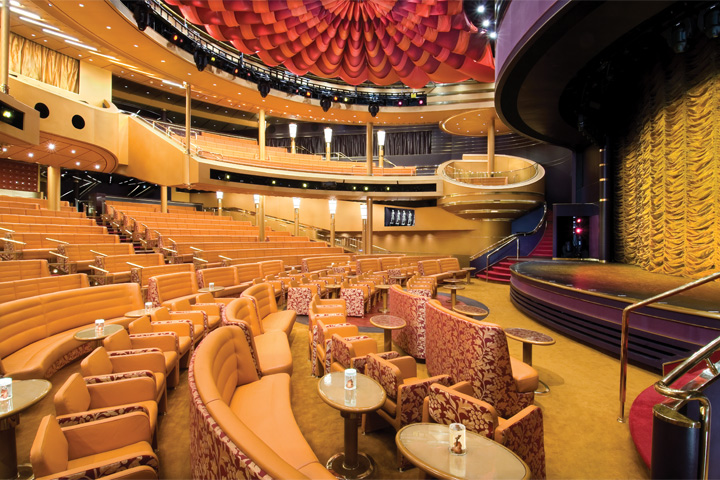
Vista Lounge
- Card Room
- Casino
- Disco/Nightclub
- Movies
- Theater/Show Lounge
- Fitness Center
- Sauna/Steam Room
- Culinary Arts Center
- Educational Programs
- Pool - Outdoor
- Sports Facilities
- Whirlpool/Jacuzzi
- Art Gallery
- Bars/Lounges
- Library
- Children's Indoor Play Area
- Organized Age Specific Activities
- Teen Center or Disco
- Teen Programs
- Business Center
- Concierge Desk
- Duty-Free Shops/Boutiques
- Elevators
- Safe Deposit Boxes
Activities & Services (available for an extra fee)
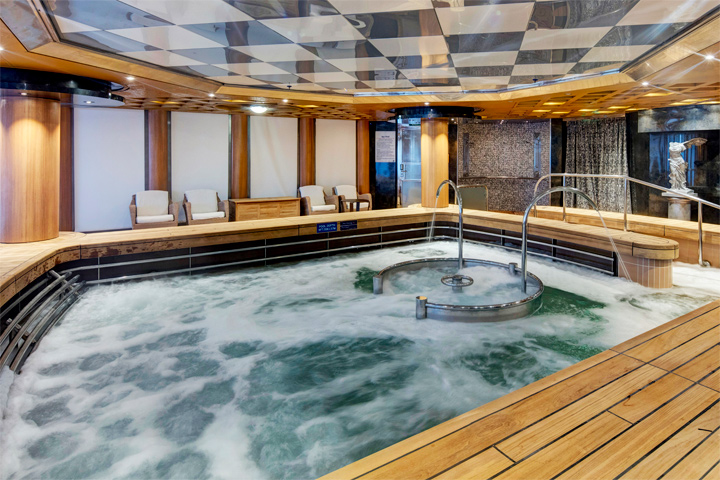
Greenhouse Spa
- Beauty Salon
- Full-Service Spa
- Internet Center
- Babysitting
- Dry Cleaning/ Laundry Service
- Infirmary/Medical Center
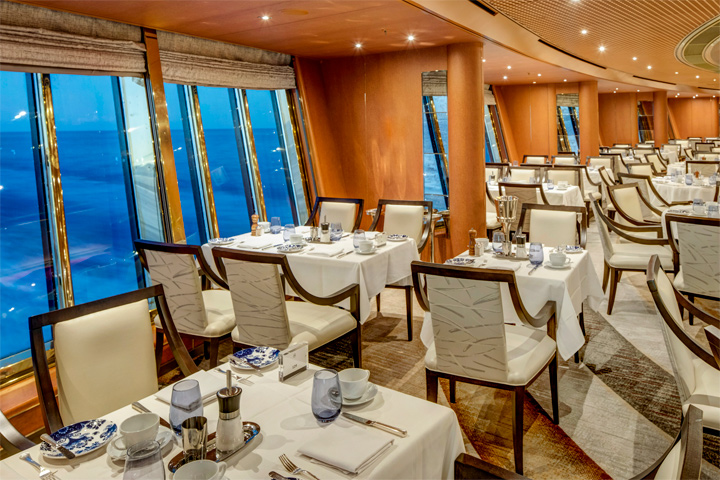
The Dining Room
Main Dining
The Dining Room: For breakfast, lunch or an unforgettable five-course dinner, the elegant main Dining Room is your destination for sophisticated dining, with menu selections from classic favorites to vegetarian options, to dishes inspired by the regions you’ll visit. Menus by Holland America Line's Culinary Council® of world-renowned chefs.
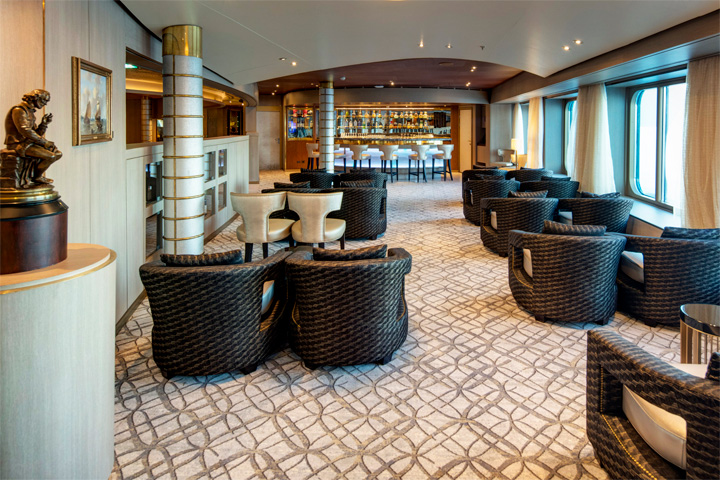
Pinnacle Grill
Specialty Dining
Pinnacle Grill: Enjoy dishes inspired by America’s Pacific Northwest, such as king salmon from Alaska and choice, responsibly raised beef from Washington State’s Double R Ranch. Complement your meal with a selection of boutique wines from the Pacific Northwest and other celebrated vineyards from around the world. This restaurant is available for an additional cost.
Canaletto: This authentic Italian restaurant offers a menu that celebrates spartire (Italian for "sharing"). Try Braised Chicken Cacciatore "al Forno", Branzino ai Ferri or a classic Italian pasta: spaghetti pomodoro or garlic shrimp-infused ravioli, perhaps. Buon appetito! This restaurant is available for an additional cost.
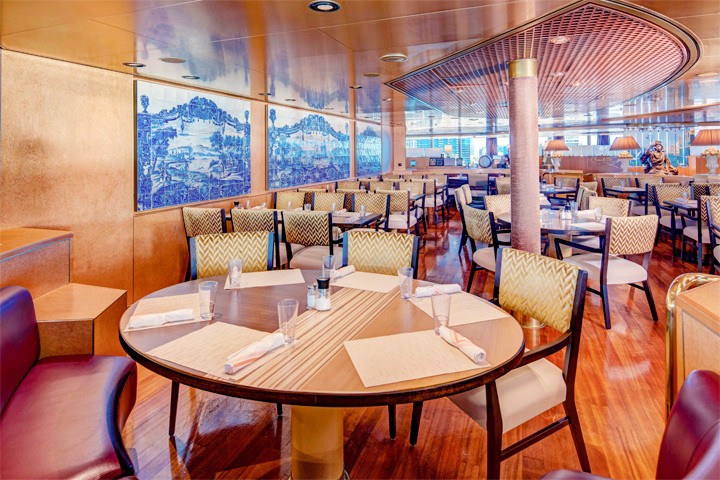
Lido Market
Casual Dining
Lido Market: Lido Market provides a fresh, new approach to casual dining for breakfast, lunch or dinner, with a panoramic view of the sea. A modern marketplace with different themed stations, the Lido offers a curated selection of delicious options to grab on the go or to have quickly made to order.
Dive-In: Dive in to a grilled burger on brioche or a Nathan’s Famous gourmet hot dog. For alfresco dining by the pool, Dive-In has it all, including lighter fare like the grilled chicken breast sandwich and vegetarian-friendly portabella mushroom stack.
Explorations Café: A comfortable, coffeehouse environment offering espresso drinks and pastries. This restaurant is available for an additional cost.
Room Service: Complimentary 24-hour dining in the comfort of your stateroom.
Staterooms feature premium massage showerheads, fine linens and fresh fruit upon request.

Category: N
Area: Approximately 151-233 sq. ft.

Category: MM
Area: Approximately 151-233 sq. ft.

Category: M
Area: Approximately 151-233 sq. ft.

Category: L
Area: Approximately 151-233 sq. ft.

Category: K
Area: Approximately 151-233 sq. ft.

Category: J
Area: Approximately 151-233 sq. ft.

Category: I
Area: Approximately 151-233 sq. ft.
Elegant staterooms feature luxurious bedding, premium massage showerheads, a porthole or a window and fresh fruit upon request.

Category: HH
Area: Approximately 174-180 sq. ft.

Category: H
Area: Approximately 174-180 sq. ft.

Category: G
Area: Approximately 174-180 sq. ft.

Category: F
Area: Approximately 174-180 sq. ft.

Category: E
Area: Approximately 174-180 sq. ft.

Category: DD
Area: Approximately 174-180 sq. ft.

Category: D
Area: Approximately 174-180 sq. ft.

Category: C
Area: Approximately 174-180 sq. ft.
Spacious staterooms have a private balcony, whirlpool bath with shower and walk-in closet.

Category: VH
2 lower beds convertible to 1 queen-size bed; Bathtub; Shower; Sitting area; Private verandah; Floor-to-ceiling windows

Category: VF
Area: Approximately 212-359 sq. ft. including verandah.

Category: VE
Area: Approximately 212-359 sq. ft. including verandah.

Category: VD
Area: Approximately 212-359 sq. ft. including verandah.

Category: VC
Area: Approximately 212-359 sq. ft. including verandah.

Category: VB
Area: Approximately 212-359 sq. ft. including verandah.

Category: VA
Area: Approximately 212-359 sq. ft. including verandah.
Luxurious suites feature a whirlpool bath, large sitting area, private balcony, floor-to-ceiling windows and more. Select suites feature a dressing room.
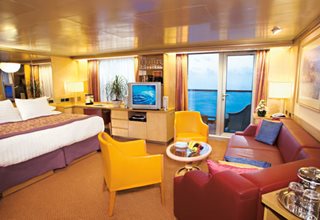
Category: SC
Area: Approximately 500-712 sq. ft. including verandah.

Category: SB
Area: Approximately 500-712 sq. ft. including verandah.

Category: SA
Area: Approximately 500-712 sq. ft. including verandah.
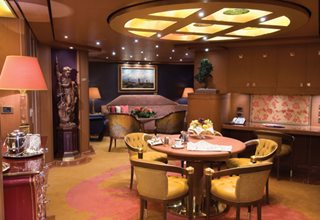
Category: PS
Area: Approximately 1,150 sq. ft. including verandah.

| Symbol | Description |
|---|---|
 | Triple (2 lower beds, 1 sofa bed) |
 | Quad (2 lower beds, 1 sofa bed, 1 upper) |
 | Partial sea view |
 | Fully obstructed view |
 | Shower only |
 | Single sink vanity |
 | Staterooms have solid steel verandah railings instead of clear-view Plexiglas railings |
 | Suites SC6175 and SC6164 are fully accessible, bathtub and roll-in shower; Suite SS6108 and staterooms I8037, VB6004, VB6003, D1100, C1082, C1081, J1074, K1012, and K1011 are fully accessible, roll-in shower only |
 | Suites SY8068, SY5002, and SY5001 are fully accessible with single side approach to the bed, bathtub, and roll-in shower |
 | Staterooms VA8032, VA8031, VA6049, VA5140, VA5137, VA5054, VA5051, VA4132, VA4131, H4090, H4089, VA4052, and VA4051 are ambulatory accessible, roll-in shower only |
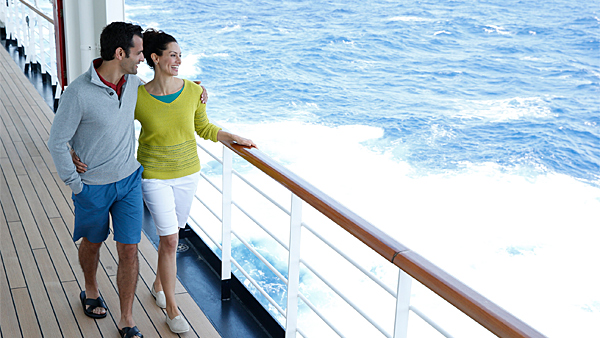
- Ship Name: Noordam
- Year Built: 2006
- Year Refurbished: 2015
- Year Entered Present Fleet: 2006
- Ship Class: Vista
- Maximum Capacity: 2,506
- Number of Passenger Decks: 11
- Number of Crew: 800
- Officers' Nationality: International
- Ocean-View without Balcony: 165
- Ocean-View with Balcony: 479
- Total Inside Staterooms: 153
- Tonnage (GRT): 82,318
- Capacity Based on Double Occupancy: 1,918
- Country of Registry: Netherlands
- Total Staterooms: 959
- Suites with Balcony: 162
- Crew/Hotel Staff Nationality: International
Available Dates & Prices
Terms & Conditions
*Price shown is per person based on double occupancy and is valid for select stateroom categories only. Click on the Terms & Conditions link below for details.
†One Digital Costco Shop Card per room/stateroom, per stay. The exact amount of the Digital Costco Shop Card will be calculated during the booking process. The Digital Costco Shop Card promotion is nontransferable and may not be combined with any other promotion. A Digital Costco Shop Card will arrive by email approximately 10 days after the start of your cruise. Click on the Terms & Conditions link below for additional information.
Ship's registry: The Netherlands
Digital Costco Shop Card
This booking includes a Digital Costco Shop Card which will arrive by email one to two weeks after you return from your vacation. The Digital Costco Shop Card is a convenient payment option in our warehouses and on Costco.com.






























